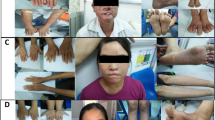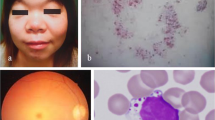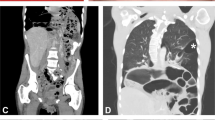Abstract
Ehlers-Danlos syndrome (EDS) is a genetically and pathogenetically heterogeneous group of disorders of which at least 11 types have been described1. All are connective tissue disorders characterized by defects of the skin, ligaments and blood vessels with the clinical spectrum ranging from innocuous findings to lethality. Mutations in the genes encoding the major fibrillar collagen types I and III have been demonstrated in EDS types VII and IV, respectively2,3, while mutations in the lysyl hydroxylase and ATP7A genes, with roles in collagen cross-linking, are responsible for EDS types VI4 and IX5. The biochemical and molecular bases for the most common forms of EDS (types I, II and III) are unknown. Here, we describe a balanced translocation between chromosome 9 and an X chromosome that disrupts the minor fibrillar collagen type V gene COL5A1 in a patient with both EDS type I and hypomelanosis of Ito. The breakpoint occurs at 9q34 within COL5A1 intron 24 and interestingly, within a LINE-1 (L1) element at Xp21.1. A fusion mRNA between COL5A1 and an Alu sequence is produced, but no aberrant protein is detectable. Rather, the amount of type V collagen is reduced in the patient's fibroblasts, suggesting haploinsufficiency as a cause of the phenotype. This demonstrates that a mutation in a type V collagen gene, COL5A1, results in EDS type I, and shows the involvement of L1 sequences in a constitutional chromosomal translocation. Because collagen type V is a het-eromorphic protein in which molecules may be composed of polypeptides encoded by three COL5A genes, this suggests all three genes as candidates for mutations in EDS.
This is a preview of subscription content, access via your institution
Access options
Subscribe to this journal
Receive 12 print issues and online access
$209.00 per year
only $17.42 per issue
Buy this article
- Purchase on Springer Link
- Instant access to full article PDF
Prices may be subject to local taxes which are calculated during checkout
Similar content being viewed by others
References
Beighton, P., Ehlers-Danlos syndromes, in McKusick's Heritable Disorders of Connective Tissue, 5th edn. (ed. Beighton, P.) 189–251 (Mosby-Year Book Inc., St. Louis, 1993).
Byers, P.H. Disorders of collagen biosynthesis and structure, in The Metabolic and Molecular Bases of Inherited Disease, 7th edn. (eds Scriver, C.R., Beaudet, A.L., Sly, W.S. & Valle, D.) 4029–4077 (McGraw-Hill, New York, 1995).
Prockop, D.J. & Kivirikko, K.I. Collagens: molecular biology, diseases, and potentials for therapy. Annu. Rev. Biochem. 64, 403–434 (1995).
Hyland, J. et al. A homozygous stop codon in the lysyl hydroxylase gene in two siblings with Ehlers-Danlos syndrome type VI. Nature Genet. 2, 228–231 (1992).
Kaler, S.G. et al. Occipital horn syndrome and a mild Menkes phenotype associated with splice site mutations at the MNK locus. Nature Genet. 8, 195–202 (1994).
Rosenberg, S., Arita, F.N., Campos, C. & Alonso, F. Hypomelanosis of Ito: case report with involvement of the central nervous system and review of the literature. Neuropediatrics 15, 52–55 (1984).
Greenspan, D.S. et al. Human collagen gene COL5A1 maps to the q34.2–q34.3 region of chromosome 9, near the locus for nail–patella syndrome. Genomics 12, 836–837 (1992).
Takahara, K., Hoffman, G.G. & Greenspan, D.S. Complete structural organization of the human 1(V) collagen gene (COL5A1): divergence from the conserved organization of other characterized fibrillar collagen genes. Genomics 29, 588–597 (1995).
Isegawa, Y. et al. Selective amplification of cDNA sequence from total RNA by cassette-ligation mediated polymerase chain reaction (PCR): application to sequencing 6.5 kb genome segment of hantavirus strain B-1. Mol. Cell. Probes. 6, 467–475 (1992).
Hutchison, C.A., Hardies, S.C., Loeb, D.D., Shehee, W.R. & Edgell, M.H. LINEs and related retroposons: long interspersed repeated sequences in the eucaryotic genome, in Mobile DNA (eds Berg, D. & Howe, M.) 593–617 (Am. Soc. Microbiol., Washington, DC, 1989).
Dombroski, B.A., Mathias, S.L., Nanthakumar, E., Scott, A.F. & Kazazian, H.H. Jr., Isolation of an active human transposable element. Science 254, 1805–1808 (1991).
Scott, A.F. et al. Origin of the human L1 elements: proposed progenitor genes deduced from a consensus DNA sequence. Genomics 1, 113–125 (1987).
Budarf, M.L. et al. Cloning a balanced translocation associated with DiGeorge syndrome and identification of a disrupted candidate gene. Nature Genet. 10, 269–278 (1995).
Holmes, S.E., Dombroski, B.A., Krebs, C.M., Boehm, C.D. & Kazazian, H.H. Jr., A new retrotransposable human L1 element from the LRE2 locus on chromosome 1q produces a chimaeric insertion. Nature Genet. 143–148 (1994).
Miki, Y. et al. Disruption of the APC gene by a retrotransposal insertion of L1 sequence in a colon cancer. Cancer Res. 52, 643–645 (1992).
von Lindern, M., Breems, D., van Baal, S., Adriaansen, H. & Grosveld, G. Characterization of the translocation breakpoint sequences of two DEK-CAN fusion genes present in t(6;9) acute myeloid leukemia and a SET-CAN fusion gene found in a case of acute undifferentiated leukemia. Genes Chrom. Cancer 5, 227–234 (1992).
Takahara, K. et al. Complete primary structure of human collagen α1(V) chain. J. Biol. Chem. 266, 13124–13129 (1991).
Greenspan, D.S., Cheng, W. & Hoffman, G.G. The pro1(V) collagen chain: complete primary structure, distribution of expression, and comparison with the pro- 1(XI) collagen chain. J. Biol. Chem. 266, 24727–24733 (1991).
Willing, M.C. et al. Osteogenesis imperfecta type I: molecular heterogeneity for COL1A1 null alleles of type I collagen. Am. J. Hum. Genet. 55, 638–647 (1994).
Greenspan, D.S. et al. COL5A1: fine genetic mapping and exclusion as candidate gene in families with nail–patella syndrome, tuberous sclerosis 1, hereditary hemorrhagic telangiectasia, and Ehlers-Danlos syndrome type II. Genomics 25, 737–739 (1995).
Loughlin, J. et al. Linkage of the gene that encodes the alpha-1 chain of type V collagen (COL5A1) to type II Ehlers-Danlos syndrome (EDS II). Hum Molec. Genet. 4, 1649–1651 (1995).
Nicholls, A.C., McCarron, S., Narcisi, P. & Pope, F.M. Molecular abnormalities of type V collagen in Ehlers Danlos syndrome. Am J. Hum. Genet. 55, A233 (1994).
Birk, D.E., Fitch, J.M., Babiarz, J.P., Doane, K.J. & Linsenmayer, T.F. Collagen fibrillogenesis in vitro: Interaction of types I and V collagen regulates fibril diameter. J. Cell Sci. 95, 649–657 (1990).
Vogel, A., Holbrook, K.A., Steinmann, B., Gitzelmann, R. & Byers, P.H. Abnormal collagen fibril structure in the gravis form (type I) of Ehlers-Danlos syndrome. Lab. Invest. 40, 201–206 (1979).
Andrikopoulos, K., Liu, X., Keene, D.R., Jaenisch, R. & Ramirez, F. Targeted mutation in the COL5A2 gene reveals a regulatory role for type V collagen during matrix assembly. Nature Genet. 9, 31–36 (1995).
Ritter, C.L., Steele, M.W., Wenger, S.L. & Coher, B.A. Chromosome mosaicism in hypomelanosis of Ito. Am. J. Med. Genet. 35, 14–17 (1990).
Sybert, V.P. Hypomelanosis of Ito: a description, not a diagnosis. J. Invest. Dermatol. 103, 141S–143S (1994).
Happle, R. Tentative assignment of hypomelanosis of Ito to 9q33–qter. Hum. Genet. 75, 98–99 (1987).
Latt, S.A., Willard, H.F. & Gerald, P.S. BrdU-33258 Hoechst analysis of DNA replication in human lymphocytes and supernumerary or structurally abnormal X chromosomes. Chromosoma. 57, 135–153 (1976).
Lichter, P. et al. High-resolution mapping of human chromosome 11 by in situ hybridization with cosmid clones. Science 247, 64–69 (1990).
Lemieux, N., Dutrillaux, B. & Viegas-Pequignot, E. A simple method for simultaneous R- or G-banding and fluorescence in situ hybridization of small single-copy genes. Cytogenet. Cell Genet. 59, 311–312 (1992).
Takahara, K., Lyons, G.E. & Greenspan, D.S. Bone morphogenetic protein-1 and a mammalian tolloid homologue (mTId) are encoded by alternatively spliced transcripts which are differentially expressed in some tissues. J. Biol. Chem. 269, 32572–32578 (1994).
Bonadio, J., Holbrook, K.A., Gelinas, R.E., Jacob, J. & Byers, P.H. Altered triple helical structure of type I procollagen in lethal perinatal osteogenesis. J. Biol. Chem. 260, 1734–1742 (1985).
Barnes, W.M. PCR amplification of up to 35-kb DNA with high fidelity and high yield from bacteriophage templates. Proc. Natl. Acad. Sci. USA 91, 2216–2220 (1994).
Cheng, S., Fockler, C., Barnes, W.M. & Higuchi, R. Effective amplification of long targets from cloned inserts and human genomic DNA. Proc. Natl. Acad. Sci. USA 91, 5695–5699 (1994).
Author information
Authors and Affiliations
Corresponding author
Rights and permissions
About this article
Cite this article
Toriello, H., Glover, T., Takahara, K. et al. A translocation interrupts the COL5A1 gene in a patient with Ehlers–Danlos syndrome and hypomelanosis of Ito. Nat Genet 13, 361–365 (1996). https://doi.org/10.1038/ng0796-361
Received:
Accepted:
Issue Date:
DOI: https://doi.org/10.1038/ng0796-361
This article is cited by
-
Resequencing of candidate genes for Keratoconus reveals a role for Ehlers–Danlos Syndrome genes
European Journal of Human Genetics (2021)
-
Segmental Arterial Mediolysis
CardioVascular and Interventional Radiology (2014)
-
Clinical and molecular characterization of 40 patients with classic Ehlers–Danlos syndrome: identification of 18 COL5A1 and 2 COL5A2 novel mutations
Orphanet Journal of Rare Diseases (2013)
-
Heritable Collagen Disorders: The Paradigm of the Ehlers—Danlos Syndrome
Journal of Investigative Dermatology (2012)
-
RNAi silencing of type V collagen in Schistosoma japonicum affects parasite morphology, spawning, and hatching
Parasitology Research (2012)



